An oft neglected area of Blood Bowl model are their bases, these tend to be the last area you work on and sometimes just want to get out the way. In doing so you risk missing out on both a valuable way to enhance the appearance of your team and useful method of streamlining the game. Many coaches convert their Blood Bowl from sci-fi and fantasy models, adding some extra details to the base can help show that these models are on a Blood Bowl pitch rather than a battlefield.
Materials
The basics of decorating the base of a Blood Bowl player are very similar to that of other models. As teams hail from all over the world they can play on a wide variety of surfaces and be subject to all sorts of weather conditions.
The techniques and materials used to represent these will not differ much from those used for sci-fi or fantasy models and are there are too many to cover in this one article.
In most cases the easiest way to texture your base is to attach the model to it with glue, pinning might be needed for some models. Then paint it as normal and once this is done start work on the base. Most of the materials shown below are loose and can be easily stuck to the base. In some instances the base will either need to be done first or the model painted separately and then attached, this will be mentioned in the relevant sections.
The image below shows most of the materials used to create the example bases in this article. Missing items are; crackle paint used in the ice flow and cracked earth desert base, clear resin for the swamp bases, plasticard for the stone and display bases as well as snow scatter for the winter base.
1. Fine grade mid-green flock, 2. Larger grade and darker flock, 3. Herbs from a supermarket. 4. Fine grade sand, 5. Small pebbles from garden, 6. Mixed brown and green static grass, 7. Bright green static grass, 8. Vinyl sheet with green fibre to resemble grass, 9. Lichen for bushes, 10. Fibres used as reeds or long grass.
Theming
Bases can be themed to the environment associated with that team to add extra character. This can be as simple as modifying the grass; High elves would play on a pristine pitch, a less well off human team might have a few patches of bare earth worn away over the season and it would be more overgrown for wood elves.
Of course plenty of races don’t live in environments conducive to the growing of neatly tended grass and have to play on a variety of other pitch types. Many teams can’t afford a large stadium and are forced to clear a patch of open ground to play on.
A selection of these are listed below.
Grass
The default pitch type would be grass, teams tend to travel a lot and play all round the world. Grass would be the most common surface to play on and suit any race, it also matches the 3rd edition boards making it the safe and easy option.
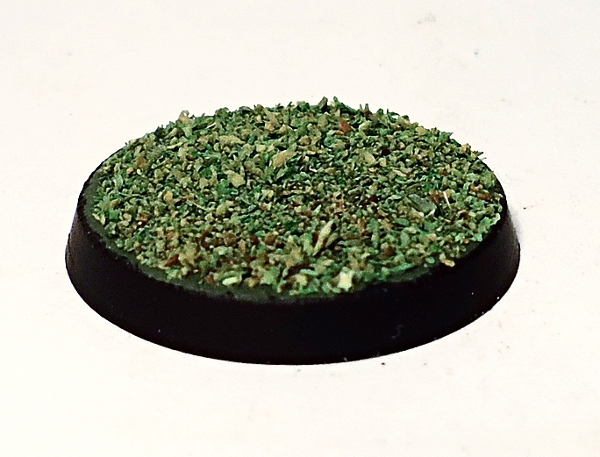 The simplest base is just painted green with the finest grade flock stuck to it. This best represents carefully manicured lawns or even astroturf, ideal for High/pro elves or rich human teams.
The simplest base is just painted green with the finest grade flock stuck to it. This best represents carefully manicured lawns or even astroturf, ideal for High/pro elves or rich human teams.
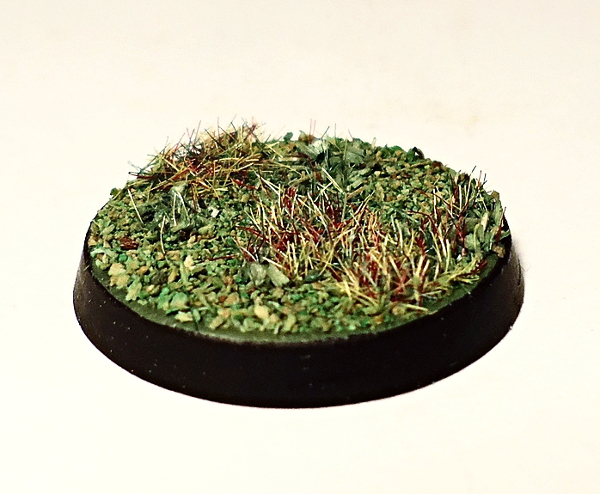 The example above can be a little flat and dull, in this case patches of a different grade of flock was added along with some areas of static grass. This gives the impression of a maintained but wilder grass field with weeds mixed in, similar to what you’d see in a local park. Any team could play on this type of pitch, it would best suit races that care about the surface but are not super fastidious humans or Halflings would be perfect examples.
The example above can be a little flat and dull, in this case patches of a different grade of flock was added along with some areas of static grass. This gives the impression of a maintained but wilder grass field with weeds mixed in, similar to what you’d see in a local park. Any team could play on this type of pitch, it would best suit races that care about the surface but are not super fastidious humans or Halflings would be perfect examples.
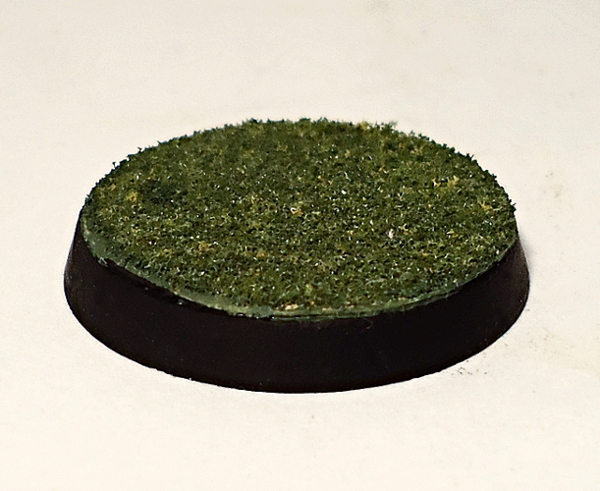 Instead of flock a sheet of vinyl can be bought from hobby shops. These come in a variety of colours and are ideal to represent a grass playing surface. They can be painted and drybrushed to represent different types of pitch. Unlike flock the vinyl sheet cannot be easily attached to the base of an already painted model. Instead the sheet will need to be glued to the base first and the model attached later. A hole can be cut for the tab when using slotta bases or drilled if the model is being pinned.
Instead of flock a sheet of vinyl can be bought from hobby shops. These come in a variety of colours and are ideal to represent a grass playing surface. They can be painted and drybrushed to represent different types of pitch. Unlike flock the vinyl sheet cannot be easily attached to the base of an already painted model. Instead the sheet will need to be glued to the base first and the model attached later. A hole can be cut for the tab when using slotta bases or drilled if the model is being pinned.
Jungle/Forests
Many races live in heavily forested areas, their pitch would need to be in a clearing or the edge of the forest/jungle. Aspects of the jungle/forest are likely to encroach on this area so in addition to grass there would be undergrowth and other plants. Extra little details can be added to differentiate between different forest types, such as exotic plants for Lustria, roots and spites for wood elves, patches of fungus for greenskins or mutated foliage for Chaos.
 These effectively take the more overgrown grass base a step further. Clumps of herbs have been added with some of them painted a darker shade of brown. The herbs are to represent dead leaves; this would be the type of pitch used by wood elves, Beastmen heavy chaos or forest goblins/savage orc teams.
These effectively take the more overgrown grass base a step further. Clumps of herbs have been added with some of them painted a darker shade of brown. The herbs are to represent dead leaves; this would be the type of pitch used by wood elves, Beastmen heavy chaos or forest goblins/savage orc teams.
 The jungle base has some large leaves, bright green static grass and long grass to show it is more lush and verdant, this is the type of pitch Lizardmen, Slann and amazons would play on.
The jungle base has some large leaves, bright green static grass and long grass to show it is more lush and verdant, this is the type of pitch Lizardmen, Slann and amazons would play on.
Swamps
Some races live near waterways or live in areas prone to flooding, this may mean that their playing surface features many puddles, pools of water or even small rivers flowing through it. It could also be that the team plays in sewers or the players themselves exude foul liquids that form puddles
Swamps are the natural habitat of Slann, but also Lizardmen, greenskins, Skaven and Nurgle could play in such areas. This would share much in common with jungle except for added pools of brackish water, getting considerably more polluted for Nurgle and Skaven. It might also feature various plants and wildlife appropriate to the race.
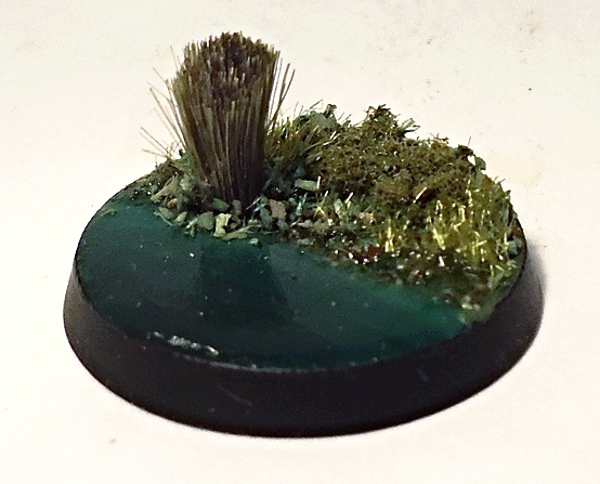 Half of this base is very similar to the jungle above. The main addition is water and the long fibres to represent reeds, this would favour skink heavy Lizardmen and Slann.
Half of this base is very similar to the jungle above. The main addition is water and the long fibres to represent reeds, this would favour skink heavy Lizardmen and Slann.
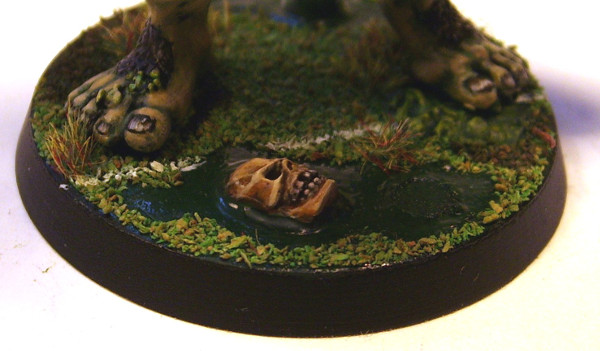 In this example the base is not a swamp as such but the disgusting Nurgle player has caused the pools of water nearby to become foul. The base is more like a wasteland with pools of polluted water, common with Nurgle, Skaven or Undead teams.
In this example the base is not a swamp as such but the disgusting Nurgle player has caused the pools of water nearby to become foul. The base is more like a wasteland with pools of polluted water, common with Nurgle, Skaven or Undead teams.
Wasteland
The very presence of certain teams will damage natural wildlife, others can only afford to play on a barren surface or care little for the upkeep of the grounds. The Undead and Chaotic teams in particular tend to kill off all plant life just through the nature of their magic. These teams would play on bare earth or rocky ground, maybe with a few patches of hardy vegetation. You’d most commonly see the less civilised or evil races playing on these types of surfaces.
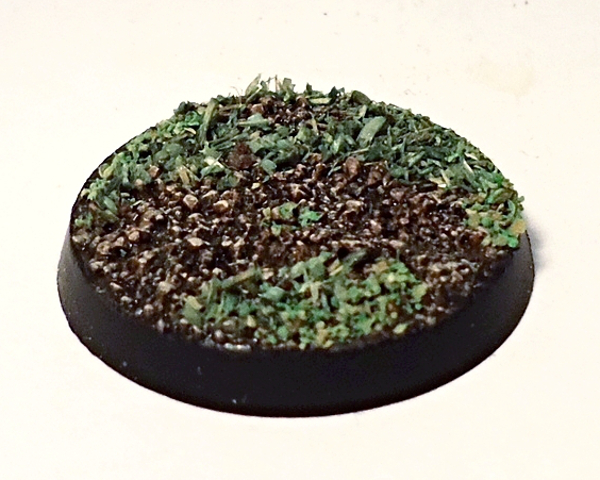 Sand is glued to this base to represent rocky ground with patches of earth to represent an area with harsher weather or a well-used pitch, it still has some greenery. Much of this base would be similar to the grass examples above, it is ideal for poorer Humans, Orcs or Ogres.
Sand is glued to this base to represent rocky ground with patches of earth to represent an area with harsher weather or a well-used pitch, it still has some greenery. Much of this base would be similar to the grass examples above, it is ideal for poorer Humans, Orcs or Ogres.
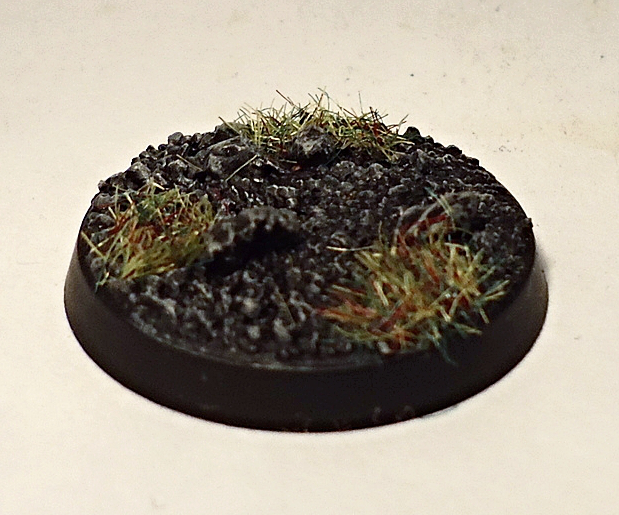 In this example the base has the sand painted black with grey highlights and a few scattered bits of static grass to represent hardy plants eking out an existence. Desolate wastelands with little growing are more commonly seen with Chaotic or Undead teams.
In this example the base has the sand painted black with grey highlights and a few scattered bits of static grass to represent hardy plants eking out an existence. Desolate wastelands with little growing are more commonly seen with Chaotic or Undead teams.
Desert
Certain races live in areas where little if any plants can grow, they may well end up playing on sand or dry, cracked earth. These could also represent teams that play in warmer areas that often suffer from droughts (if you roll sweltering heat a lot), there may have been grass before but it has since been killed off.
 A very simple and easy surface to do is sand, it can be left as is or painted brown and drybrushed with light shades such as this example. This gives the impression of a sand desert or even a beach, the most likely team to play on this would be Khemri teams.
A very simple and easy surface to do is sand, it can be left as is or painted brown and drybrushed with light shades such as this example. This gives the impression of a sand desert or even a beach, the most likely team to play on this would be Khemri teams.
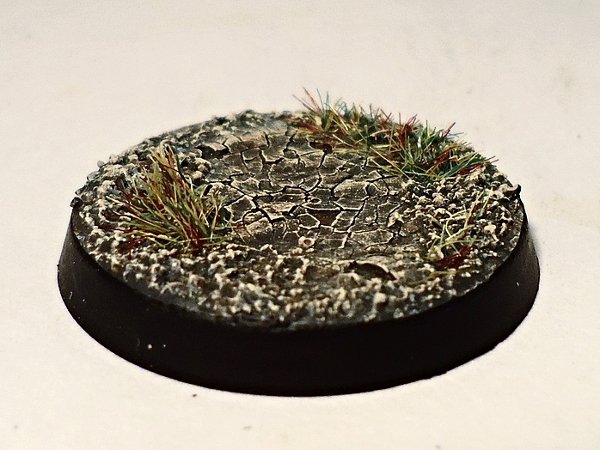 In comparison this is an American style desert with cracked bare earth, some rocks and a few dry plants. This effect is done by spreading crackle paint in the centre and gluing fine grade sand round the edges. The whole base is painted a warm grey and then drybrushed with lighter shades of brownish grey before patches of static grass were added. Khermi teams could play on this as could humans or orcs that live in hotter climates.
In comparison this is an American style desert with cracked bare earth, some rocks and a few dry plants. This effect is done by spreading crackle paint in the centre and gluing fine grade sand round the edges. The whole base is painted a warm grey and then drybrushed with lighter shades of brownish grey before patches of static grass were added. Khermi teams could play on this as could humans or orcs that live in hotter climates.
Snow/Ice
Most associated with Norse, but plenty of other races play in chilly environments such as dark elves, northern Humans, Chaos, Ogres and even those handful of weird Dwarven teams that like going outside. It can be as simple as adding snow to grass or wasteland pitches all the way through to playing on ice flows.
 Making a snow covered base is easily done by adding patches of snow scatter to a grass or wasteland type base. The brown wasteland base from above had snow scatter glued to it. Lots of teams play in colder climates which have regular snow falls and if you roll the snow weather often then you might want to show that on your team.
Making a snow covered base is easily done by adding patches of snow scatter to a grass or wasteland type base. The brown wasteland base from above had snow scatter glued to it. Lots of teams play in colder climates which have regular snow falls and if you roll the snow weather often then you might want to show that on your team.
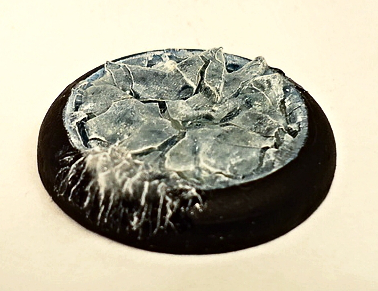 The ice flow is a costly and time consuming method but does create a very unique looking surface, a full description of how this was achieved can be found here. It only really suits the type of teams that live very far north such as Norse, Chaos or Dark elves.
The ice flow is a costly and time consuming method but does create a very unique looking surface, a full description of how this was achieved can be found here. It only really suits the type of teams that live very far north such as Norse, Chaos or Dark elves.
Artificial surfaces
Not all Blood Bowl pitches will be played on natural surfaces, some teams such as Dwarfs, Skaven and underworld reside underground, whilst the influence of chaotic teams can warp everything around them. Most famous of all is the Astrogranite pitch, those who played 2nd edition will be familiar with the polystyrene board that came with the boxed game.
Any team could play on Astrogranite or other artificial surface; it might be they are rich enough to afford a custom pitch, be underground so play on a flat stone (or metal if in a dwarven stronghold) or some wacky chaos invention that could be pretty much anything your fevered imagination could come up with. Not all artificial surfaces are stone, you could have a team playing on wooden floors if it is an indoor ground or coastal team.
There are a couple of ways to represent these types of playing surface.
Painting
The easiest method is painting the base itself, you may need to fill any holes to ensure it is a flat surface. Then it is just a case of painting the base to represent the planks of wood, stone or anything else. You can paint cracks, markings or designs onto these as well for extra detail. It is quite a time consuming method and you may prefer to devote that effort to the models themselves.
The difficult thing about this method is you will either have to do it before attaching the model or have to be very careful when working on the feet. Painting straight lines can be particularly challenging in these circumstances.
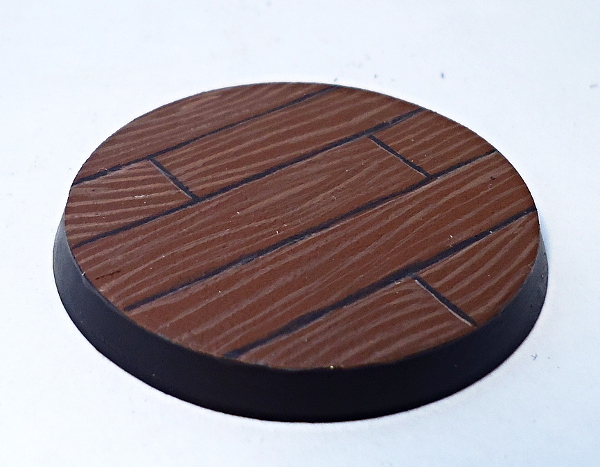 If your team is from a coastal area they might play on the docks, alternatively it could be an area with wooden floor. The base was painted a mid-brown with the planks being outlined in dark brown and the grain added in a light brown.
If your team is from a coastal area they might play on the docks, alternatively it could be an area with wooden floor. The base was painted a mid-brown with the planks being outlined in dark brown and the grain added in a light brown.
Adding
The more time consuming, but also the more impressive looking way is to add something to the shape of the surface and stick it to the base. It could be sculpted on with putty, although geometric shapes are difficult to sculpt, a simpler method is to glue plasticard or balsawood onto the base and pant it. Cardboard could also be used but it has a tendency to warp when glued or painted.
Thin sheets of plasticard can be purchased online or from hobby shops. This can then be cut to represent the slabs of metal/stone/Astrogranite and glued to the base. The advantage of plastic is that it can be sanded after being cut, allowing edges to be rounded or tidied up. To get the plasticard to fit round bases you can either make a template by sacrificing a base and cutting off the rims or finding something of the correct size. For instance the UK pound coin fits nicely the top of 25mm bases. It is better to cut the plastic slightly too large as it can always be sanded back. Multiple light cuts rather than a single big cut is the safer way and also allows mistakes to be corrected more easily. In fact the plastic does not always need to be cut all the way through and can be snapped off.
Logos or designs can be incorporated into the base by drawing the design onto the plastic or printing it out and sticking it to the plastic as a guide. I prefer to reverse the design and stick it to the back as the initial cuts can go awry and this way they are not visible. The edges of the parts that are cut out can then be lightly sanded to remove rough edges and allow them to be stuck back together. This technique is ideal for a display base, where you want the bases of the models to fit in with the section of the pitch used. Later in the article display bases will be described in more detail.
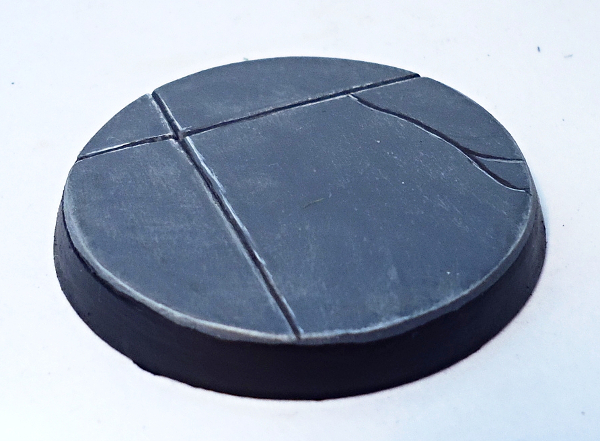 Plasticard was cut to shape and then stuck onto this base to represent stone slabs or Astrogranite, it was then painted mid grey and drybrushed with a lighter shade. The crack was painted on but it could just as easily have been cut into the plastic.
Plasticard was cut to shape and then stuck onto this base to represent stone slabs or Astrogranite, it was then painted mid grey and drybrushed with a lighter shade. The crack was painted on but it could just as easily have been cut into the plastic.
Extra Decoration
If you look carefully at the 3rd edition cardboard pitch you can see all manner of extra detail. Churned up earth caused by particularly violent encounters, trash or rocks thrown by fans and even bits of armour or body parts from players! Adding these things like this will give your team more character and better represent them as playing on a Blood Bowl pitch rather than some random field or bit of wasteland.
Churned earth
Only appropriate for certain surfaces, the brutal clashes or acrobatic displays can have an impact on the field. Players may well have slid about whilst battling for dominance on the LOS or when diving to catch a pass.
It is pretty easy to represent this, just get some putty and stick it to the base, then either use a tool or the foot of a model to drag it into shape. This can then be painted brown and any flock or grass left off that part. You can go one stage further by adding the divots or clumps of earth dug up by this activity.
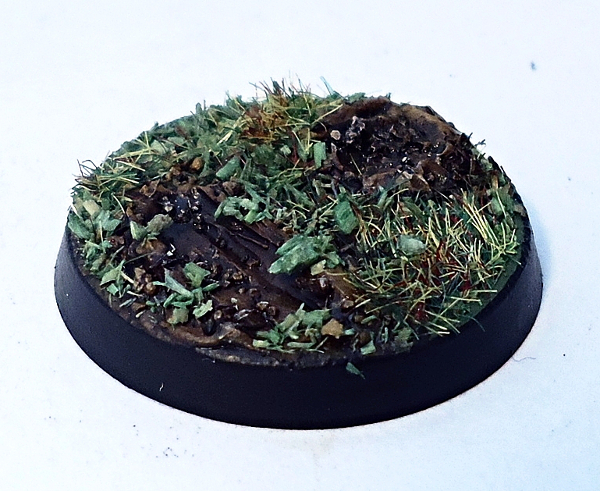 The addition of this bit of torn up earth made from greenstuff with some stones adds a lot more character to the otherwise flat green base.
The addition of this bit of torn up earth made from greenstuff with some stones adds a lot more character to the otherwise flat green base.
Blood Bowl Specific Trash
As a game progresses debris will tend to accumulate, it might be trash or rocks thrown by fans, bits of armour broken loose during collisions or even body parts from unfortunate players themselves! Some of this debris might not be cleared up after each game, certain teams won’t be bothered by mess and may feel more at home playing on a pitch covered in rubbish and rotting body parts (Skaven, Undead and Nurgle all spring to mind).
The Blood Bowl fluff is filled with many pun versions of existing brands and these can be brought into model form by adding some trash to the base. Things like cans of Orca Cola, bottles of Bloodweiser, newspaper or programs and pennants or scarves from fans could also feature.
 A vinyl grass matt was painted brown and drybrushed the represent sand. The can of Orca-cola was made from a plastic rod and the newspaper taken from a tattered bit of cloth.
A vinyl grass matt was painted brown and drybrushed the represent sand. The can of Orca-cola was made from a plastic rod and the newspaper taken from a tattered bit of cloth.
Throw a Rock
Stones are likely to be found on many pitches, as discussed above plenty of teams play on rocky ground or wasteland, even grass pitches may get dug up and stones brought to the surface.
Missiles sometimes get chucked at players, most famously the “throw a rock” kick off event and this can be represented with small stones. Extra detail can be added with blood stains from a successful hit or theming the missile. It might have been part of the stadium or a statue that was thrown and so bits from themed terrain can be used. Often fantasy banner tops are a good source; they can be chopped up as if they were broken off a statue or if flat stuck to a bit of plasticard to represent a panel that was smashed from the stadium.
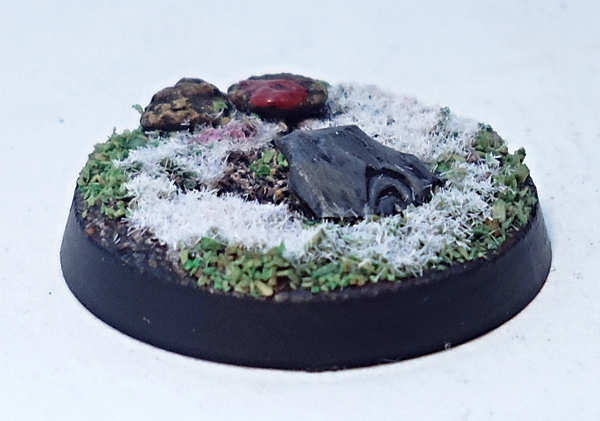 Both rock types are illustrated with this base. Small stones from were painted to give more depth and one had an added blood stain, whilst a elven waystone was used to represent a section of carved stone that had been broken off and hurled at a player.
Both rock types are illustrated with this base. Small stones from were painted to give more depth and one had an added blood stain, whilst a elven waystone was used to represent a section of carved stone that had been broken off and hurled at a player.
Armour and body parts
The last and most grisly bit of debris you are likely to come across comes from the players themselves. The sheer brutality of the blocks and fouls committed in a game means it is likely that uniforms will get ripped and pieces of armour wrenched off. Even worse than that, body parts may get torn off, or dead players left to decay on the field.
Broken bits of armour are easy to represent. They may be ripped off or trampled over you can easily take pretty much any bit of armour or even things like shields or bits from sci-fi models can work as these can be cut up and half buried. Plastic models are the best for this as they are easy to cut and in multi-part kits you often have bits left over.
Body parts are pretty straight forward as well, there are plenty of undead models available, even race specific ones and these can be chopped up and stuck to the base to represent bits of ex-players left to rot from previous matches.
Unwanted Blood Bowl models are the best source of both armour and body parts, it is a bit extreme and pricey to chop up a perfectly good model just for a base. However if you happen to have spare bits from conversions or some of the plastic models from the 3rd edition boxed set then these can be ideal.
These bits of armour or bodies can be themed, painting them to represent a hated rival in your league. Maybe even adding trophies of memorable kills to the base of your team’s deadliest player.
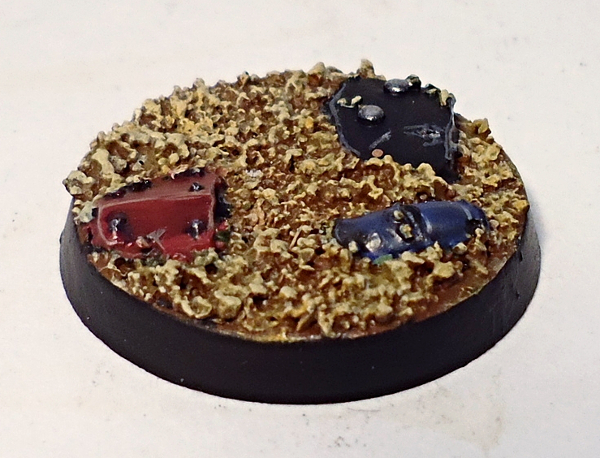 Armour plates from a 40K Ork, a shield from a Tomb King Skeleton and a spare forearm guard from a Blood Bowl model were added to this base. They were hacked up and some part buried to show it had been there for a long time
Armour plates from a 40K Ork, a shield from a Tomb King Skeleton and a spare forearm guard from a Blood Bowl model were added to this base. They were hacked up and some part buried to show it had been there for a long time
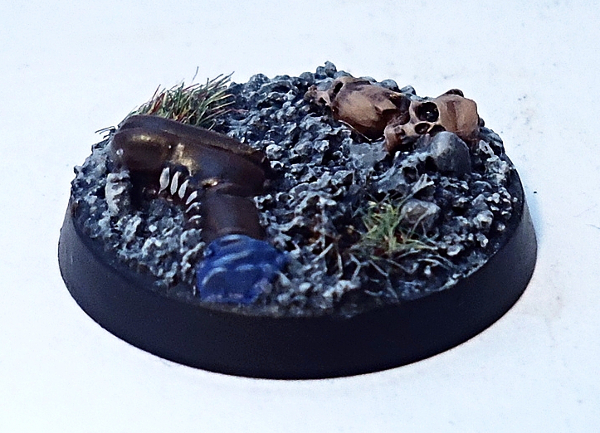 Some skeleton bits were used for the long dead bodies of players and these were part buried in the ground. The leg is from a more recent casualty and was taken from a plastic human thrower whose arm and head had already been used in other conversions.
Some skeleton bits were used for the long dead bodies of players and these were part buried in the ground. The leg is from a more recent casualty and was taken from a plastic human thrower whose arm and head had already been used in other conversions.
Bought bases
Several companies sell bases of various types such as swamp, ruins, volcanic planks and desert. These are a quick way to represent these surfaces, though they will still need to be painted and extra Blood Bowl details such as those mentioned later in the article can be added to them.
Pitch Markings
Rather than playing on plain grass or dirt, Blood Bowlers compete on a field which will have markings to denote the line of scrimmage, sidelines and touchdown area for each team. Adding these markings to a base is one of the easiest little touches you can do to differentiate it from a plain field.
The simplest method is to paint the markings onto the sand or flock on the base, usually these will be white, but if the base is very light (sand for Khemri for instance) then black may be better. If you’ll be adding static grass to the base it is better to do this after painting as it is very hard to paint these. Any reeds, bushes or rocks can be ignored, assuming these came after the lines were painted.
American football fields often have the team badge painted in the centre and coloured designs in the endzones. This type of field can be shown on bases in a similar way to the markings by painting the base. If you are planning on making a display base (see below for more details) then you can do the entire team logo and have some players be standing on parts of it.
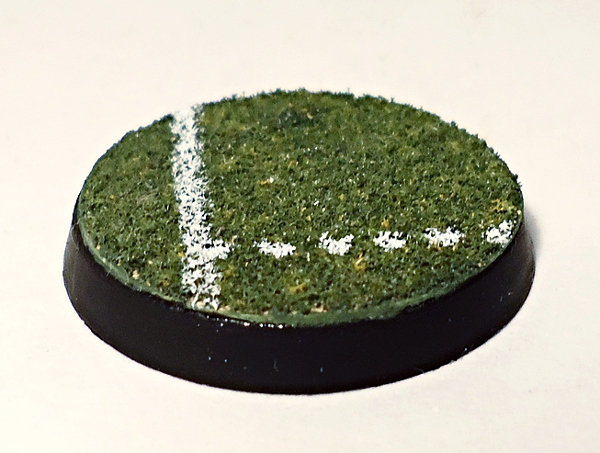 The simplest and quickest ways to show your models are on a Blood Bowl pitch is to add some painted lines. This has a mixture of solid and dotted lines similar to those found on American Football fields.
The simplest and quickest ways to show your models are on a Blood Bowl pitch is to add some painted lines. This has a mixture of solid and dotted lines similar to those found on American Football fields.
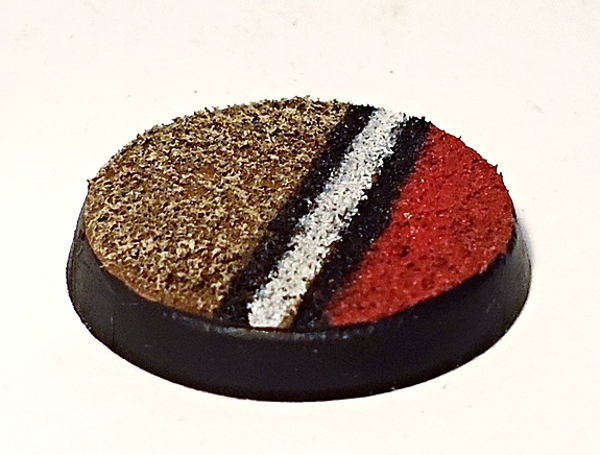 The advantage of using a vinyl sheet is that you can paint an entire design onto it and then cut bits out to stick to the bases of individual players. These will then match up with the team logo, ideal for display bases as covered later in the article.
The advantage of using a vinyl sheet is that you can paint an entire design onto it and then cut bits out to stick to the bases of individual players. These will then match up with the team logo, ideal for display bases as covered later in the article.
Going big
Using larger bases allows more detail to be added, whilst a display base can really highlight your team’s background and tie all players, staff and even fans together.
Dioramas
You might want to go one stage further with some bases and turn them into a mini-diorama. Star players in particular suit this as not only will a more elaborate base indicate they are special but these are the ideal models to turn into a centrepiece of your team. Key rostered players such as catchers or blitzers could also get this treatment.
The player can be modelled doing what they are most known for, a catcher might be running or diving in for a touchdown whilst a blitzer could be standing over a downed foe. This is a great opportunity to avenge defeats against hated foes or teams by having their downed players added to the base.
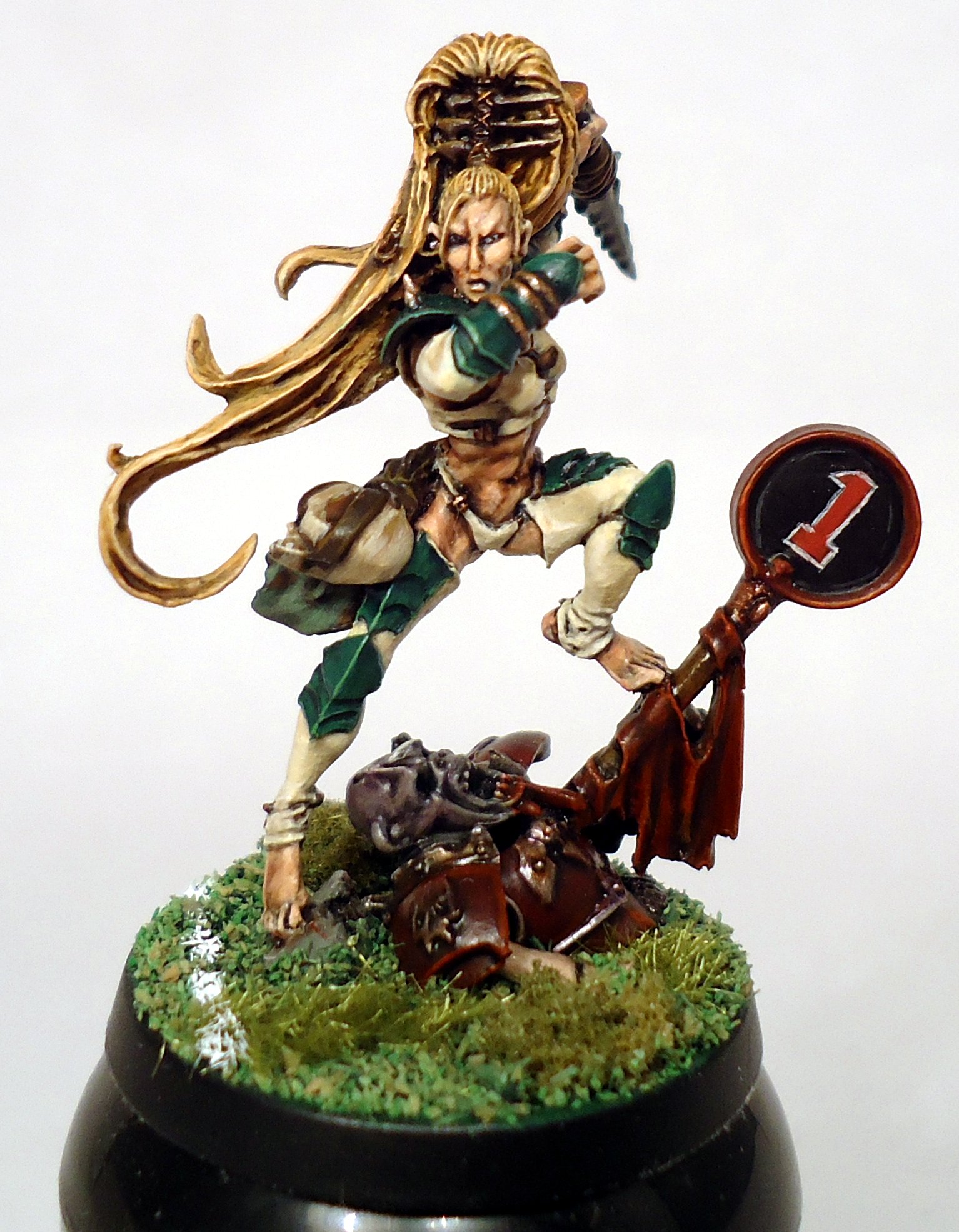 It was necessity rather than design that required this base to become a diorama. Zara is made from the dark eldar character Lilieth and is modelled standing on a banner stuck in a piece of rubble. This would have looked silly on a Blood Bowl model so the banner was changed into a 1st down marker and a staked vampire’s dying body used to hide the rubble.
It was necessity rather than design that required this base to become a diorama. Zara is made from the dark eldar character Lilieth and is modelled standing on a banner stuck in a piece of rubble. This would have looked silly on a Blood Bowl model so the banner was changed into a 1st down marker and a staked vampire’s dying body used to hide the rubble.
Display Bases
If you’ve gone to all the trouble of lovingly painting a full team, including stars and coaching staff you might want to tie them all together with a display base. It is pretty common to see these amongst the nominees for best painted teams at tournaments. A wide variety of materials can be used and they range from the players standing on their home field to those that are especially large and elaborate. It is an ideal way to illustrate the background of the team and to further show the theme if they have one.
The most basic display base can be a board of some sort that the players are placed on. The advantage of this is that they can be moved about to best show off the team and it is quick to do.
I prefer something a little more advanced where a sheet of foamboard is used and holes cut in it for the players. This can be stuck to a stand made of wood (these can be made with a router or bought from DIY/trophy suppliers. A cheaper alternative is to use photo frames, not only do they come with a wide variety of sizes and borders, but they are also pretty cheap.
A display base is easily large enough to showcase the team badge and you can add this to parts of some players bases to break up the monotony of them all being the same. Vinyl grass sheets can be bought from hobby shops and these are ideal for this, then glued to the foamboard and painted if needed to represent wasteland or desert pitches. You can then paint the logo onto the field and cut out disks to stick to the players’ bases. Bear in mind that bases are wider at the bottom so you’ll have to trim these down.
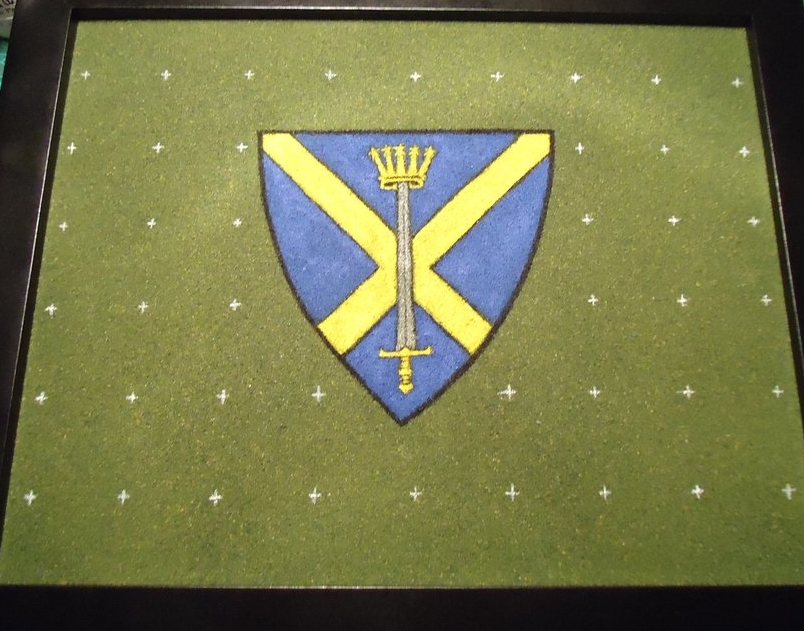 The grass sheet was stuck to foam board and the team logo was then painted by hand onto the middle of this sheet along with some other pitch markings.
The grass sheet was stuck to foam board and the team logo was then painted by hand onto the middle of this sheet along with some other pitch markings.
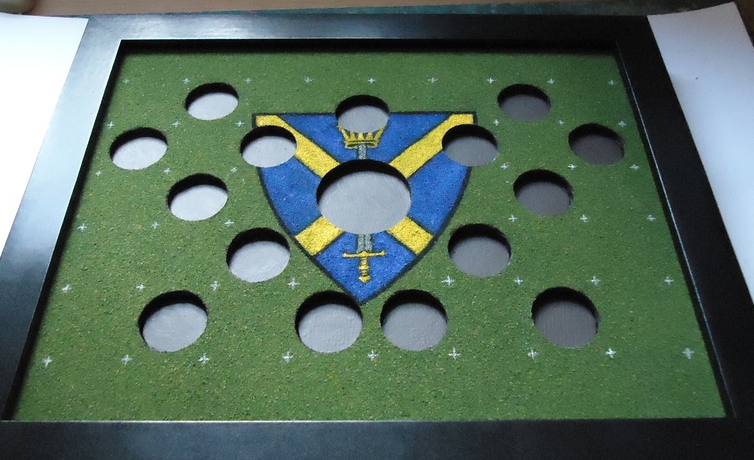 Bases were used as guides to cut holes in the vinyl sheet and foamboard. As you can see a large base and 3 small bases have some of the team badge on them.
Bases were used as guides to cut holes in the vinyl sheet and foamboard. As you can see a large base and 3 small bases have some of the team badge on them.
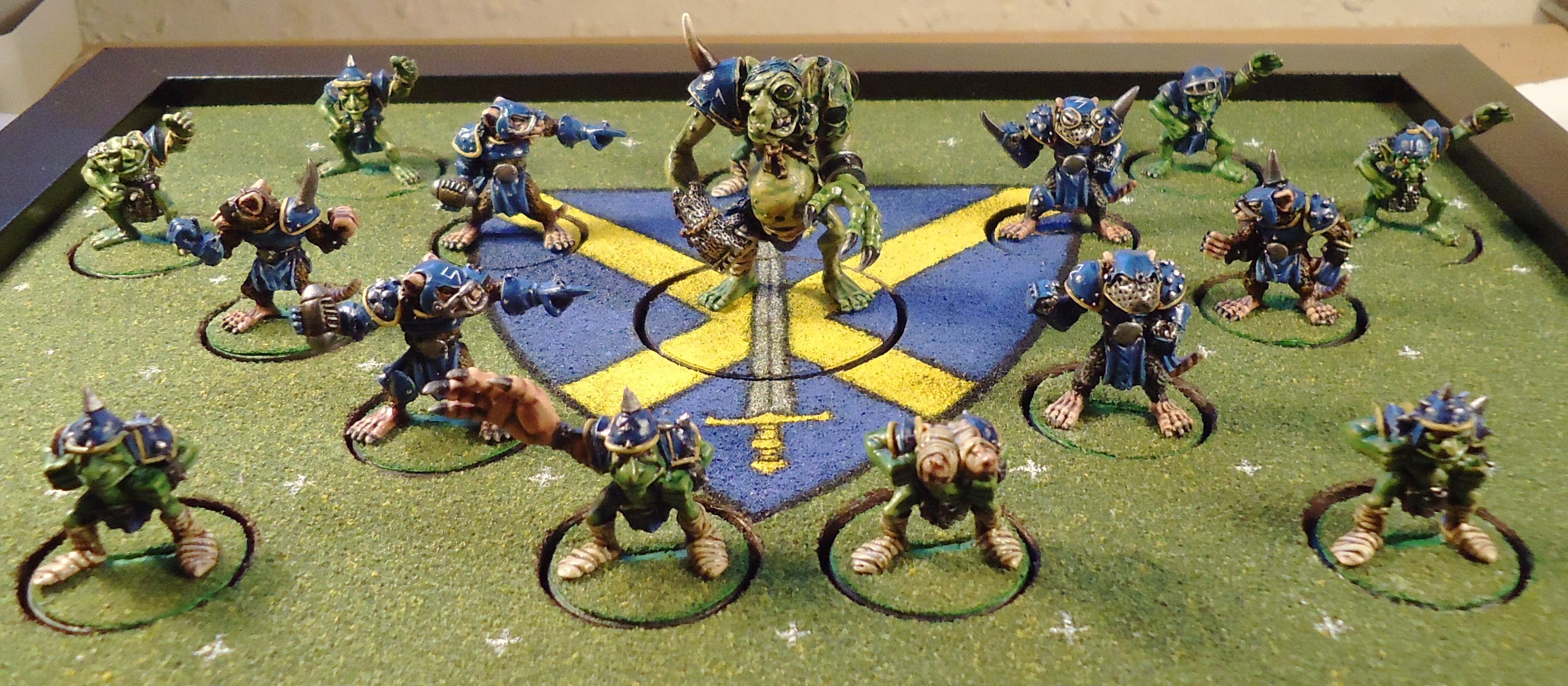 The disks cut from the vinyl sheet were kept and stuck to the players’ bases. Note that as these are metal models with tabs a slot had to be cut into these to fit the tab. Alternatively the tabs could be removed and the player pinned to the base directly.
The disks cut from the vinyl sheet were kept and stuck to the players’ bases. Note that as these are metal models with tabs a slot had to be cut into these to fit the tab. Alternatively the tabs could be removed and the player pinned to the base directly.
Another option is to use the plasticard artificial surface technique described above to add the team logo onto the foamboard. Either just the logo or the entirety of the display base can be covered in plasticard. Using this method will create a three dimensional design, but it is hard work. The design and any slabs of the pitch will need to be cut out and then holes will need to be cut into these and the disks trimmed to fit the bases. This will take quite a bit of time and likely several knife blades, so it is advisable to practise with some spare bits first.
 In this instance the NAF logo was simplified and reversed before being printed out and stuck to the back of the plasticard. The individual parts were cut out and sanded to fit better, since it was to represent an old mosaic the corners were rounded slightly. A base was used as a guide to cut the circle in the middle and then a smaller template to cut it to fit onto the base. The advantage of gluing it to the foamboard beforehand is that the design held was together. The foamboard was then trimmed back to just the paper and stuck to the base. The logo was then painted in team colours and the rest of the foamboard painted green.
In this instance the NAF logo was simplified and reversed before being printed out and stuck to the back of the plasticard. The individual parts were cut out and sanded to fit better, since it was to represent an old mosaic the corners were rounded slightly. A base was used as a guide to cut the circle in the middle and then a smaller template to cut it to fit onto the base. The advantage of gluing it to the foamboard beforehand is that the design held was together. The foamboard was then trimmed back to just the paper and stuck to the base. The logo was then painted in team colours and the rest of the foamboard painted green.
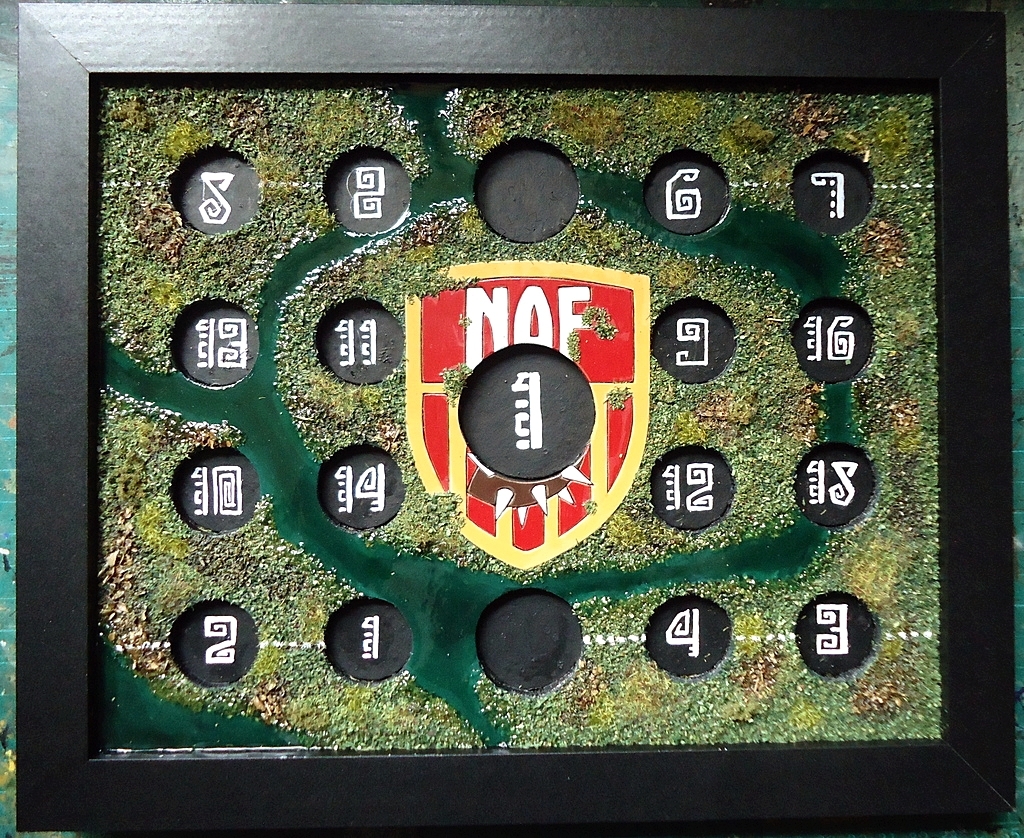 Once this had been finished the base was decorated using the jungle swamp technique as described above. Where the water overlaps players’ bases this was continued over them as well. Some of the flock was glued to the badge to represent the jungle encroaching onto it. The numbers are to help line up the players with the correct slot.
Once this had been finished the base was decorated using the jungle swamp technique as described above. Where the water overlaps players’ bases this was continued over them as well. Some of the flock was glued to the badge to represent the jungle encroaching onto it. The numbers are to help line up the players with the correct slot.
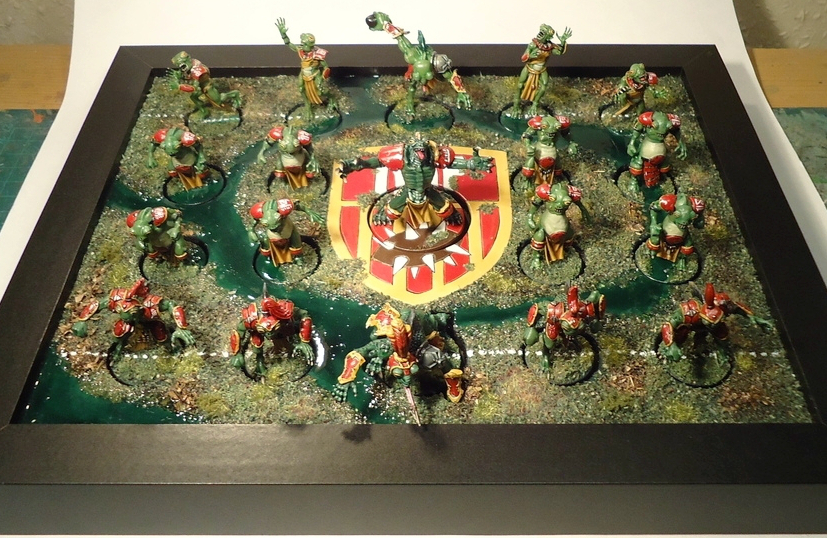 The finished base shows how the players fit on it and both the pitch markings and swamp waters match the display base.
The finished base shows how the players fit on it and both the pitch markings and swamp waters match the display base.
Base rims
When 3rd edition first came out the tradition was to paint all bases green including the rims. The convention has shifted over time and now the rim of the base being black is more common.
Players in Blood Bowl are a lot more individualistic than the soldiers used in tabletop battle games as they have individual characteristics and skills that change over their career. Non-progression tournament coaches have long used markers to denote which players on a team have skills, be these coloured base rims or elastic bands. This helps both coaches remember which players have been given skills on top of those they come with. So the rim of the base can be a valuable tool to speed up the game and avoid having to consult the roster every few minutes.
The base can also be used to help differentiate between the positional players in a team as this is not always obvious. Many players do not have a nice flat bit of armour to paint their team number on and the base gives an obvious and consistent alternative to this.
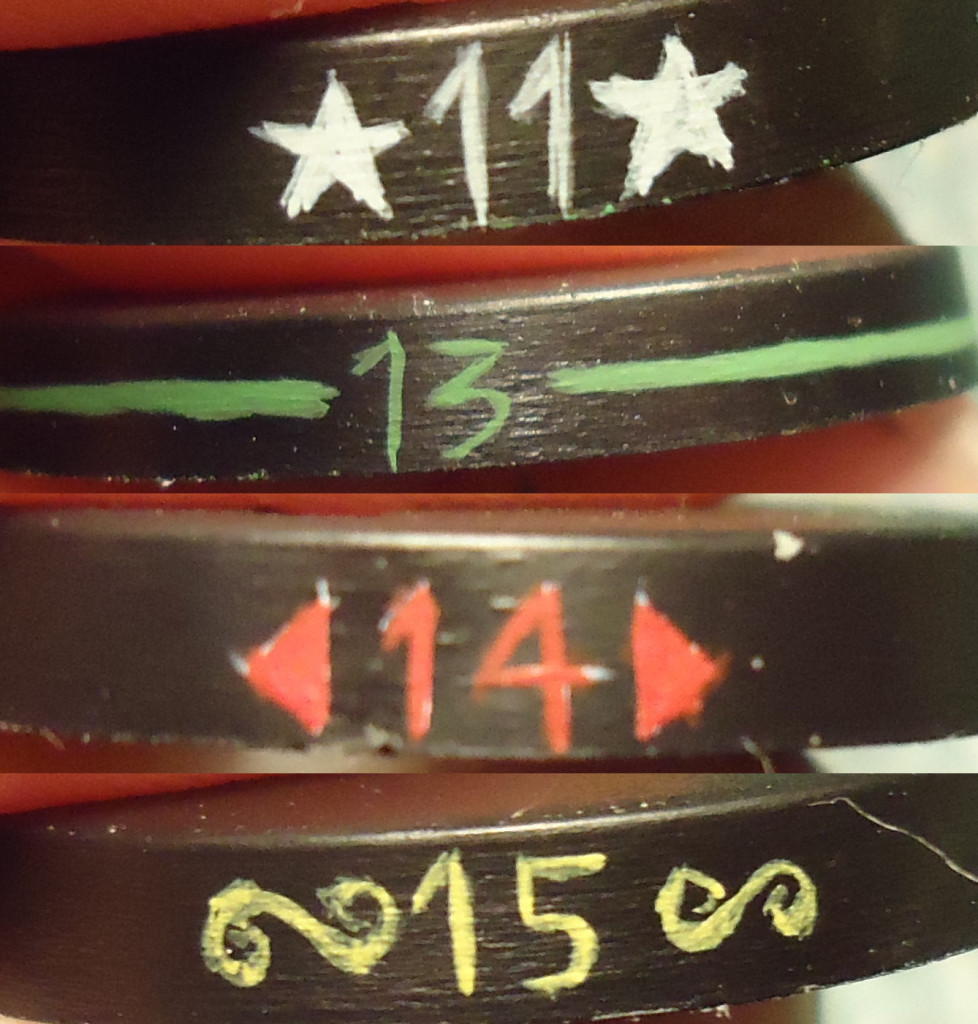 Colour coding has been combined with numbers to show which position each player has. The traditional colouring is; grey – linemen, white – throwers, yellow – catchers, red – blitzers and green – blockers. The symbols beside the number are for decorative purposes and make the colouring more obvious.
Colour coding has been combined with numbers to show which position each player has. The traditional colouring is; grey – linemen, white – throwers, yellow – catchers, red – blitzers and green – blockers. The symbols beside the number are for decorative purposes and make the colouring more obvious.
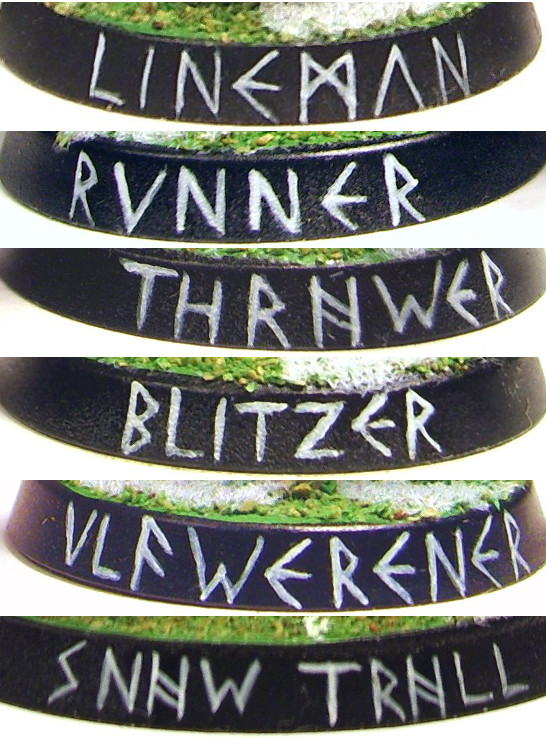 If you have a converted team and are worried that positional players are hard to distinguish then you can write these on the bases as has been done with this Norse team. The writing was themed to have a runic style. Alternatively you could also add the skills they have as reminder, either those they start with or have picked up in the tournament/season.
If you have a converted team and are worried that positional players are hard to distinguish then you can write these on the bases as has been done with this Norse team. The writing was themed to have a runic style. Alternatively you could also add the skills they have as reminder, either those they start with or have picked up in the tournament/season.

